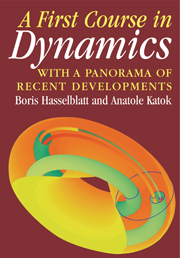Book contents
- Frontmatter
- Contents
- Preface
- 1 Introduction
- PART 1 A COURSE IN DYNAMICS: FROM SIMPLE TO COMPLICATED BEHAVIOR
- 2 Systems with Stable Asymptotic Behavior
- 3 Linear Maps and Linear Differential Equations
- 4 Recurrence and Equidistribution on the Circle
- 5 Recurrence and Equidistribution in Higher Dimension
- 6 Conservative Systems
- 7 Simple Systems with Complicated Orbit Structure
- 8 Entropy and Chaos
- PART 2 PANORAMA OF DYNAMICAL SYSTEMS
- Reading
- APPENDIX
- Hints and Answers
- Solutions
- Index
3 - Linear Maps and Linear Differential Equations
Published online by Cambridge University Press: 05 June 2012
- Frontmatter
- Contents
- Preface
- 1 Introduction
- PART 1 A COURSE IN DYNAMICS: FROM SIMPLE TO COMPLICATED BEHAVIOR
- 2 Systems with Stable Asymptotic Behavior
- 3 Linear Maps and Linear Differential Equations
- 4 Recurrence and Equidistribution on the Circle
- 5 Recurrence and Equidistribution in Higher Dimension
- 6 Conservative Systems
- 7 Simple Systems with Complicated Orbit Structure
- 8 Entropy and Chaos
- PART 2 PANORAMA OF DYNAMICAL SYSTEMS
- Reading
- APPENDIX
- Hints and Answers
- Solutions
- Index
Summary
In this chapter the complexity of the dynamical behavior increases slightly over that observed in the examples in Chapter 2. In particular, periodic motions are now present in both discrete and continuous time. At the same time, in most linear systems, that is, linear maps and linear differential equations, the orbit structure is easy to understand (the limited elliptic complexity that arises from complex eigenvalues on the unit circle is discussed in the first sections of the next two chapters). We describe it carefully here. This involves linear algebra, but it is not simply a repetition of it because we investigate the dynamical aspects of linear systems, paying attention to the asymptotic behavior under iteration. Thus, this chapter serves to augment the range of asymptotic behaviors that we are able to describe. Our development takes place first in the plane and then in Euclidean spaces of any dimension.
Aside from widening our horizons in terms of the possibilities for asymptotic behavior, understanding linear maps is useful for the study of nonlinear maps by way of linearization, which was first discussed in Section 2.1.2. This is most directly the case when one wants to understand the asymptotic behavior of orbits near a fixed point of a nonlinear dynamical system, but it can also help study the relative behavior of orbits and help describe the global orbit structure. One place where this is discussed explicitly is in Section 6.2.2.7.
- Type
- Chapter
- Information
- A First Course in Dynamicswith a Panorama of Recent Developments, pp. 73 - 95Publisher: Cambridge University PressPrint publication year: 2003



